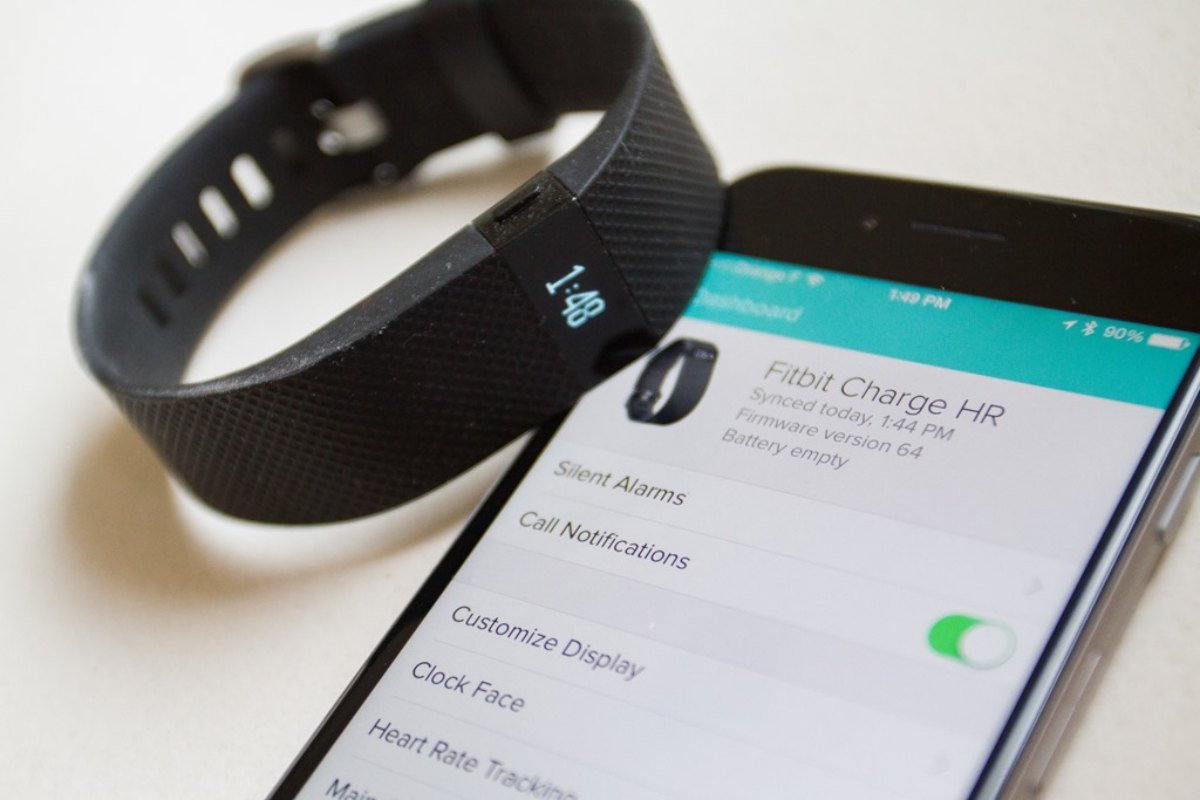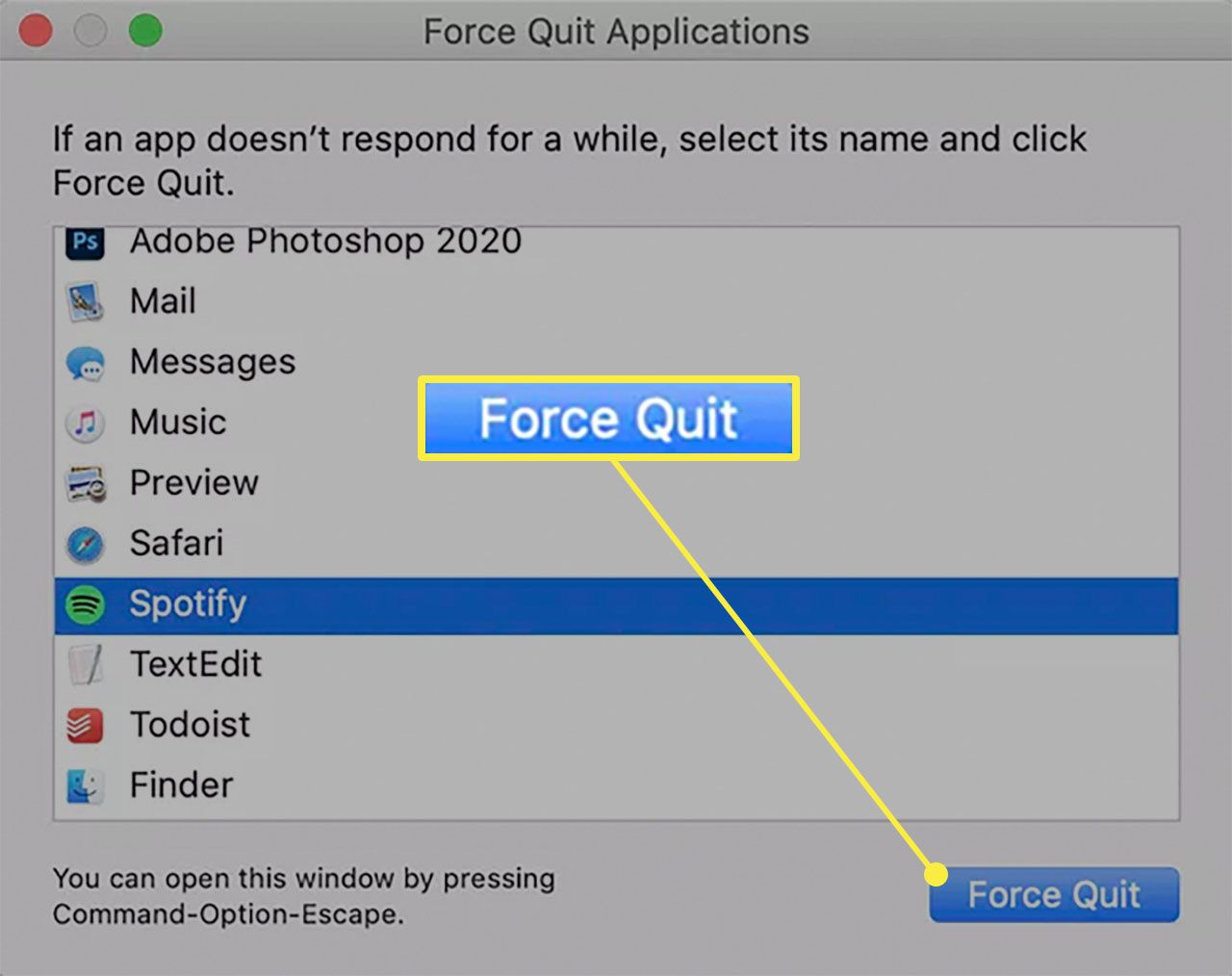Introduction
Force quitting is a crucial skill for every PC user to have. Whether you’re dealing with a frozen program, an unresponsive application, or a system-wide issue, force quitting can provide a quick solution. In this article, we will explore the concept of force quitting and discuss the various methods to do so on different platforms.
Force quitting refers to the act of closing an application or program forcefully, bypassing the normal exit procedure. It essentially terminates the process associated with the application or program, allowing you to regain control over your computer. While ideally, all applications should close without any issues, there are situations where an application might become unresponsive or fail to close properly. In such cases, force quitting becomes necessary to prevent any negative impact on the system’s performance.
There are several reasons why you may need to force quit an application. For instance, a program may freeze or become unresponsive due to a software glitch or compatibility issue. It can also happen if an application is consuming excessive system resources, causing the entire system to slow down or crash. Additionally, force quitting may be necessary when you encounter a program that refuses to close even after clicking the “Close” button repeatedly.
Now that we understand the importance of force quitting, let’s delve into the methods for force quitting on different operating systems. In the following sections, we will cover the step-by-step instructions for force quitting on Windows, Mac, and Linux, along with some troubleshooting tips to help you navigate common issues.
What is Force Quitting?
Force quitting is a technique used to forcibly close unresponsive or malfunctioning applications on a computer system. It allows you to terminate a program that is not responding to user commands or is causing system instability. When an application freezes, becomes unresponsive, or fails to close properly, force quitting provides a solution to regain control over your computer.
Force quitting bypasses the normal exit procedure of an application and terminates the associated process directly. This means that any unsaved data or changes in the application may be lost, so it’s important to use this method as a last resort when all other options have failed.
When you force quit an application, you essentially tell the operating system to terminate the process associated with that specific application. This can be useful in situations where an application is consuming excessive system resources, causing your computer to slow down or freeze. By force quitting the problematic application, you can free up system resources and restore smooth operation.
Force quitting can be done through various methods depending on the operating system you are using. On Windows, you can use the Task Manager, Alt+F4, Ctrl+Alt+Del, or even Command Prompt to force quit applications. Mac users have options such as the Activity Monitor, Force Quit Applications window, or Terminal to force quit unresponsive programs. Linux users can rely on the System Monitor, xkill command, or kill command to forcefully close troublesome applications.
It’s worth mentioning that force quitting should be used as a temporary measure to resolve immediate issues. It’s essential to investigate the root cause of the problem and find a permanent solution to prevent recurring issues. In some cases, force quitting an application may cause data loss or corruption if files were not saved properly. Therefore, it’s always advisable to save your work frequently to minimize the risk of information loss.
In the following sections, we will explore the step-by-step instructions for force quitting applications on Windows, Mac, and Linux, as well as provide troubleshooting tips to help you handle common issues. Let’s dive in and discover how you can effectively force quit problematic applications on your computer.
Reasons to Force Quit on PC
There are several reasons why you might need to force quit an application on your PC. Understanding these reasons will help you identify when force quitting is necessary and allow you to take appropriate action. Here are some common scenarios where force quitting becomes a crucial step:
- Unresponsive Applications: When an application becomes unresponsive and fails to respond to your commands, force quitting is often the only way to regain control. This can happen due to various reasons such as software glitches, memory leaks, or conflicts with other applications.
- System Freezing: Sometimes an application can cause your entire system to freeze or become unresponsive. In such cases, force quitting the problematic application can help restore normal system functionality and prevent your PC from crashing.
- High CPU Usage: If an application is consuming an excessive amount of CPU resources, it can slow down your entire system. Force quitting the resource-intensive application will free up system resources and improve overall performance.
- Application Crashes: Occasionally, applications may crash and stop working unexpectedly. In such situations, force quitting the crashed application allows you to restart it and continue working without having to restart your PC.
- Long Application Exit Time: Some applications may take a long time to exit or close down due to various factors. If you need to close the application quickly, force quitting can help expedite the process and save you time.
- Task Manager Unavailable: In certain instances, like when the Task Manager becomes unresponsive or inaccessible, force quitting via alternative methods becomes necessary to terminate problematic applications.
It’s important to note that force quitting should be used sparingly and as a last resort. Before force quitting an application, it is advisable to save any unsaved work to prevent data loss. Additionally, consider closing open files and ending tasks in a proper manner whenever possible to minimize the need for force quitting.
In the next sections, we will guide you through various methods to force quit applications on different operating systems, including Windows, Mac, and Linux. These methods will help you handle unresponsive applications and ensure the smooth operation of your PC.
How to Force Quit on Windows
Windows provides several methods to force quit applications when they become unresponsive or refuse to close. In this section, we will explore four common methods to force quit applications on Windows:
- Using Task Manager: The Task Manager is a built-in Windows utility that allows you to manage running processes and applications. To force quit an application using Task Manager, press Ctrl + Shift + Esc to open the Task Manager window. Locate the unresponsive application under the “Processes” or “Applications” tab, right-click on it, and select “End Task” or “End Process.”
- Using Alt+F4: This method works if the unresponsive or frozen application has an open window. Simply click on the application window to bring it into focus and press Alt + F4 on your keyboard. This should trigger the application to close forcefully.
- Using Ctrl+Alt+Del: When an application becomes unresponsive and you’re unable to use other methods, you can try the Ctrl+Alt+Del shortcut. Press Ctrl + Alt + Del on your keyboard to open a menu, and then select “Task Manager.” Inside the Task Manager, find the problematic application, right-click on it, and choose “End Task.”
- Using Command Prompt: If the graphical methods fail to force quit the application, you can resort to using Command Prompt. Open the Command Prompt by pressing Windows + R, typing “cmd” in the Run dialog, and pressing Enter. In the Command Prompt window, use the command “taskkill /f /im application.exe” to forcefully terminate the application. Replace “application.exe” with the actual name of the unresponsive application.
These methods provide effective ways to force quit unresponsive applications on Windows. However, it’s important to exercise caution when using the force quitting methods, as they may cause data loss if files have not been saved. Always make sure to save your progress in open applications before force quitting them to prevent any unintended consequences.
In the following sections, we will explore how to force quit applications on Mac and Linux systems. It’s essential to familiarize yourself with these methods to handle unresponsive applications effectively on different platforms.
Method 1: Using Task Manager
One of the most common methods to force quit unresponsive applications on Windows is by using the Task Manager. The Task Manager is a built-in utility that allows you to monitor and manage running processes and applications on your computer. Here’s how you can force quit an application using Task Manager:
- Press Ctrl + Shift + Esc on your keyboard. This shortcut will open the Task Manager window.
- In the Task Manager window, you’ll see several tabs. The default tab is the “Processes” tab, which lists all the running processes on your computer. You can also switch to the “Applications” tab if you prefer a more user-friendly view.
- Locate the unresponsive application that you want to force quit in the list. You can look for the application’s name or its associated process.
- Right-click on the unresponsive application and select either “End Task” or “End Process.” The exact wording may vary depending on your version of Windows.
- A confirmation pop-up may appear, notifying you that closing the application forcefully may result in data loss. If you have unsaved work in the application, it’s crucial to save your progress before proceeding. Click “End Task” or “End Process” to force quit the application.
After completing these steps, the Task Manager will terminate the selected application’s process, effectively force quitting it. You should now be able to regain control over your computer.
Using Task Manager is an effective method to force quit applications, especially when they become unresponsive or fail to close through regular means. However, keep in mind that force quitting applications may result in data loss if you have not saved your work. It’s always recommended to save your open files and close applications properly whenever possible to minimize the risk of losing important data.
In the next sections, we will explore additional methods to force quit applications on Windows, including using Alt+F4, Ctrl+Alt+Del, and Command Prompt. These methods provide alternative options to handle unresponsive applications and ensure the smooth operation of your computer.
Method 2: Using Alt+F4
Another quick and convenient method to force quit unresponsive applications on Windows is by using the Alt+F4 keyboard shortcut. This method works well when the unresponsive application has an open window that you can access. Here’s how you can force quit an application using Alt+F4:
- Click on the window of the unresponsive application to bring it into focus. Make sure the window is active and selected.
- Press the Alt key on your keyboard and while holding it, press the F4 key. The Alt+F4 combination is a universal Windows shortcut for closing the current active window.
- Doing this will send a close signal to the application and force it to quit. If the application is responsive to the command, it will close normally.
- If the application is unresponsive and refuses to close, you can repeat the Alt+F4 combination a few times to forcefully terminate the application.
Using Alt+F4 is a quick and efficient method to force quit applications on Windows. It allows you to directly close the active window of an unresponsive application, bypassing the need to access the Task Manager. This method is particularly useful when you want to force quit a single application without affecting other running processes.
However, it’s important to note that force quitting an application using Alt+F4 may not always work if the application is completely frozen or if it doesn’t respond to the command. In such cases, you can resort to using other force quitting methods like the Task Manager, Ctrl+Alt+Del, or Command Prompt.
In the next section, we will explore an alternative method to force quit applications on Windows using Ctrl+Alt+Del. This method provides an additional option when dealing with unresponsive applications and helps ensure a smooth user experience on your PC.
Method 3: Using Ctrl+Alt+Del
Ctrl+Alt+Del is a powerful keyboard combination that opens a menu known as the “Security Options” or “Windows Security” menu in Windows. This menu provides various options, including the ability to lock your computer, switch users, change passwords, and access the Task Manager. In situations where an application becomes unresponsive and you can’t use other methods to force quit it, using Ctrl+Alt+Del can often provide a solution. Here’s how you can force quit an application using Ctrl+Alt+Del:
- Press the Ctrl, Alt, and Del keys simultaneously on your keyboard. This will bring up the “Security Options” or “Windows Security” menu.
- In the menu, you’ll see several options. Select “Task Manager” to open the Task Manager window.
- Inside the Task Manager window, navigate to the “Processes” or “Applications” tab, depending on your version of Windows.
- Look for the unresponsive application that you want to force quit in the list of processes or applications.
- Right-click on the problematic application and choose “End Task” or “End Process.” This will forcefully terminate the application’s process.
By using Ctrl+Alt+Del and accessing the Task Manager, you can force quit unresponsive applications that are causing issues on your computer. This method provides a quick way to terminate stubborn applications and regain control over your system.
It’s worth noting that the Ctrl+Alt+Del shortcut is a powerful combination that goes beyond force quitting applications. It also allows you to access other security options, such as locking your computer or switching users. However, when dealing with unresponsive applications, using Ctrl+Alt+Del to launch the Task Manager is a reliable solution.
If neither Ctrl+Alt+Del nor the previous methods work for force quitting an application, you can consider using Command Prompt, as outlined in the next section. This method allows you to forcefully terminate applications through the command line interface of Windows.
Method 4: Using Command Prompt
If you encounter an unresponsive application on Windows and the previous methods fail to force quit it, you can try using Command Prompt to terminate the process. Command Prompt is a command-line interface that allows you to execute various commands on your computer. Here’s how you can force quit an application using Command Prompt:
- Press Windows + R on your keyboard to open the Run dialog. Type
cmdand press Enter to launch Command Prompt. - In the Command Prompt window, type the command
taskkill /f /im application.exe, replacingapplication.exewith the name of the unresponsive application’s executable file. For example, if the application’s executable file isnotepad.exe, the command would betaskkill /f /im notepad.exe. - Press Enter to execute the command. If multiple processes with the same name are running, you may be prompted to choose which process to terminate. Enter the corresponding number and press Enter again.
- If the command executed successfully, the unresponsive application’s process will be forcefully terminated, effectively force quitting the application.
Using Command Prompt to force quit applications provides an alternative method when other options are not successful. It allows you to directly terminate the process associated with the application, bypassing any graphical interfaces.
It’s important to exercise caution when using Command Prompt, as executing commands incorrectly may have unintended consequences. Make sure you enter the command correctly and validate the process name before pressing Enter to avoid terminating the wrong process.
In the next sections, we will explore how to force quit applications on Mac and Linux systems. These methods will provide you with options to handle unresponsive applications effectively on different platforms.
How to Force Quit on Mac
Mac provides several methods to force quit unresponsive applications. The steps may vary slightly depending on the macOS version you are using, but the basic principles remain the same. In this section, we will explore three common methods to force quit applications on Mac:
- Using Activity Monitor: Activity Monitor is a built-in utility on macOS that allows you to monitor and manage running processes. To force quit an application using Activity Monitor, open the Finder, navigate to “Applications” > “Utilities,” and launch Activity Monitor. In the Activity Monitor window, locate the unresponsive application in the “Process Name” column, select it, and click on the “X” button in the toolbar. Confirm the action when prompted to force quit the application.
- Using Force Quit Applications Window: The Force Quit Applications window provides a convenient way to force quit applications directly from the Mac menu. To access the window, click on the Apple menu in the top-left corner of the screen and select “Force Quit.” In the Force Quit Applications window, locate the unresponsive application, select it, and click on the “Force Quit” button. Confirm the action when prompted to close the application forcefully.
- Using Terminal: Terminal, the command-line interface on macOS, provides an alternative method to force quit applications. Open Terminal from “Applications” > “Utilities.” In the Terminal window, type the command
killall application-name, replacingapplication-namewith the actual name of the unresponsive application. Press Enter to execute the command, and the application will be forcefully terminated.
These methods allow you to effectively force quit unresponsive applications on a Mac. It’s important to note that force quitting an application may result in data loss if you have not saved your work. Always make sure to save your open files and close applications properly whenever possible to minimize the risk of losing important data.
In the following sections, we will explore how to force quit applications on Linux systems using various methods. Understanding these methods will help you handle unresponsive applications effectively and ensure the smooth operation of your computer.
Method 1: Using Activity Monitor
Activity Monitor is a built-in utility on macOS that allows you to monitor and manage running processes and applications. It provides a convenient way to force quit unresponsive applications on a Mac. Here’s how you can use Activity Monitor to force quit an application:
- Open the Finder on your Mac and navigate to the “Applications” folder.
- Go to the “Utilities” subfolder and launch Activity Monitor.
- In the Activity Monitor window, you will see a list of processes and applications currently running on your Mac.
- In the “Process Name” column, locate the unresponsive application that you want to force quit. You can also use the search bar in the top-right corner to quickly find the application.
- Select the problematic application by clicking on it.
- Click on the “X” button in the toolbar, which represents the “Quit Process” icon. Alternatively, you can use the keyboard shortcut Command + Q.
- A confirmation dialog will appear, asking if you want to quit the selected process. Click on “Force Quit” to forcefully terminate the application.
Using Activity Monitor allows you to identify and force quit unresponsive applications with ease. It provides a visual representation of the system’s processes and allows you to take control of any problematic applications that are causing issues on your Mac.
It’s important to note that force quitting an application may result in data loss if you have not saved your work. Make sure to save your files and close applications properly whenever possible to minimize the risk of losing important data.
In the next sections, we will explore other methods to force quit applications on Mac, including using the Force Quit Applications window and Terminal. These methods provide additional options to handle unresponsive applications effectively on a Mac.
Method 2: Using Force Quit Applications Window
The Force Quit Applications window provides a convenient and straightforward method to force quit unresponsive applications on a Mac. It allows you to view all running applications and forcefully close any problematic ones. Here’s how you can use the Force Quit Applications window:
- Click on the Apple icon in the top-left corner of the screen to open the Apple menu.
- In the Apple menu, select “Force Quit” from the dropdown list. Alternatively, you can use the keyboard shortcut Command + Option + Escape to directly access the Force Quit Applications window.
- The Force Quit Applications window will appear, displaying a list of all running applications on your Mac.
- Locate the unresponsive application that you want to force quit in the list. The application might be marked as “Not Responding.”
- Select the problematic application by clicking on it.
- Click on the “Force Quit” button in the bottom-right corner of the window.
- A confirmation dialog will appear, asking if you want to force quit the selected application. Click on “Force Quit” to forcefully terminate the application.
Using the Force Quit Applications window provides a user-friendly interface to easily identify and force quit unresponsive applications on a Mac. It allows you to swiftly handle problematic applications and regain control over your system.
Remember to save your work in open applications before force quitting them to prevent any potential data loss. It’s always recommended to properly close applications whenever possible to minimize the risk of losing important information.
In the next section, we will explore an alternative method to force quit applications on a Mac using Terminal. This method provides a command-line approach for terminating unresponsive applications.
Method 3: Using Terminal
Terminal, the command-line interface on macOS, provides an alternative method to force quit applications. Using Terminal allows you to forcefully terminate unresponsive applications directly through the command line. Here’s how you can use Terminal to force quit an application:
- Open the Finder on your Mac and navigate to “Applications” > “Utilities.”
- Launch Terminal from the Utilities folder.
- In the Terminal window, type the command
killall application-nameand press Enter. Replaceapplication-namewith the name of the unresponsive application you want to force quit. For example, if the application’s name is Safari, the command would be:killall Safari. - The system will attempt to terminate the application immediately. If successful, the application will be forcefully closed.
Using Terminal to force quit applications provides a command-line approach for terminating unresponsive processes. It can be useful when other methods, such as Activity Monitor or the Force Quit Applications window, are not accessible or effective.
Be cautious when using Terminal to force quit applications, as executing commands incorrectly may have unintended consequences. Ensure that you enter the command correctly, with the precise application name, to avoid terminating the wrong process.
Remember that force quitting an application may result in data loss if you have not saved your work. Always save your files and close applications properly whenever possible to minimize the risk of losing important information.
In the following sections, we will explore how to force quit applications on Linux systems using various methods. These methods will provide you with options to handle unresponsive applications effectively and ensure the smooth operation of your computer.
How to Force Quit on Linux
Linux systems offer several methods to force quit unresponsive applications, providing users with the flexibility to handle such situations effectively. In this section, we will explore three common methods to force quit applications on Linux:
- Using System Monitor: System Monitor is a graphical utility that allows you to monitor and manage running processes on your Linux system. To force quit an application using System Monitor, open the System Monitor application from your system’s menu or application launcher. In the Processes tab, locate the unresponsive application, select it, and click on the “End Process” or “Kill” button to terminate the application forcefully.
- Using the xkill Command: The xkill command is a quick and straightforward method to force quit applications on Linux. Open the terminal and type the command
xkill. Your mouse cursor will turn into an “X” symbol. Click on the window of the unresponsive application, and Linux will forcefully terminate it. - Using the kill Command: The kill command allows you to terminate processes on your Linux system, including unresponsive applications. Open the terminal and use the following command:
kill -9 process-ID. Replaceprocess-IDwith the actual process ID of the unresponsive application, which you can find using the ps command. This will forcefully terminate the process and the associated application.
These methods enable you to effectively force quit unresponsive applications on Linux systems. They provide options to terminate problematic processes and regain control over your system.
When force quitting applications on Linux, keep in mind that you may lose unsaved work and data. It’s essential to save your files and close applications properly whenever possible to minimize the risk of losing important information.
In the next sections, we will explore troubleshooting tips and common issues related to force quitting applications on various platforms. These tips will help you handle any challenges that may arise and ensure a smooth computing experience.
Method 1: Using System Monitor
System Monitor is a graphical utility commonly available on Linux systems that allows users to monitor and manage running processes. It provides an effective method to force quit unresponsive applications on Linux. Here’s how you can use the System Monitor to force quit an application:
- Open the System Monitor application from your system’s menu or application launcher. The exact location may vary depending on your Linux distribution and desktop environment.
- In the System Monitor window, you will see tabs or sections displaying various system-related information.
- Navigate to the “Processes” tab, which lists all the running processes on your system.
- In the process list, locate the unresponsive application that you want to force quit. You can sort the processes by name, CPU usage, or memory usage to find it quickly.
- Select the problematic application by clicking on it or highlighting its entry in the list.
- Click on the “End Process” or “Kill” button, typically located in the toolbar or context menu. Confirm any prompts or warnings that may appear.
By using System Monitor, you can identify and force quit unresponsive applications on Linux with ease. It provides a visual representation of the system’s processes, including information on CPU and memory usage, enabling you to take control of problematic applications causing issues on your system.
Remember to save your work in open applications before force quitting them to avoid potential data loss. Properly closing applications whenever possible is always recommended to minimize the risk of losing important information.
In the following sections, we will explore additional troubleshooting tips and common issues related to force quitting applications on various platforms. These tips will help you handle any challenges that may arise and ensure a smooth computing experience.
Method 2: Using xkill Command
The xkill command is a simple and effective method to force quit unresponsive applications on Linux systems. It provides a quick way to terminate problematic processes with minimal effort. Here’s how you can use the xkill command:
- Open the terminal on your Linux system. You can typically find it in the applications menu or by using the keyboard shortcut Ctrl + Alt + T.
- In the terminal, type the command
xkilland press Enter. This command will activate the xkill tool. - Your mouse cursor will change to an “X” symbol.
- Move the cursor to the window of the unresponsive application that you want to force quit.
- Click on the window, and Linux will forcefully terminate the associated application.
The xkill command provides a convenient method to force quit unresponsive applications without needing to search for the application’s process ID or navigate through system utilities. It is a useful option, especially when other methods are not readily available or effective.
When using the xkill command, it’s important to note that it terminates the entire application, including any unsaved work or data. Hence, save your files and close applications properly whenever possible to minimize the risk of losing important information.
In the next section, we will explore another method to force quit applications on Linux using the kill command. This command offers more flexibility and control over terminating specific processes on your Linux system.
Method 3: Using kill Command
The kill command is a versatile and powerful utility available on Linux systems that allows you to terminate processes, including unresponsive applications, with precision. It provides greater control over specific processes and offers a flexible method to force quit applications. Here’s how you can use the kill command:
- Open the terminal on your Linux system. You can typically find it in the applications menu or by using the keyboard shortcut Ctrl + Alt + T.
- To identify the process ID (PID) of the unresponsive application, you can use commands like
psortop. For example, you might runps aux | grep application-nameto find the process ID associated with the application you want to force quit. - Once you have the process ID, type the command
kill -9 process-IDin the terminal and press Enter. Replace process-ID with the actual process ID of the unresponsive application. - The kill command, with the
-9option, forcefully terminates the process associated with the specified process ID.
The kill command provides a precise and granular method to force quit applications on Linux. By targeting specific processes, you can terminate unresponsive applications without affecting other running processes or the overall system stability.
It’s important to exercise caution when using the kill command, as terminating processes abruptly may have unintended consequences. Ensure you enter the correct process ID and use the appropriate options to force quit the desired application.
Remember to save your work in open applications to prevent any potential data loss. Regularly saving your files and closing applications properly whenever possible is always recommended.
In the following sections, we will explore troubleshooting tips and common issues related to force quitting applications on various platforms. These tips will assist you in handling any challenges that may arise and ensure a smooth computing experience.
Troubleshooting Tips
While force quitting applications can resolve many issues, it’s essential to identify the root cause and troubleshoot to prevent future occurrences. Here are some troubleshooting tips to aid you in handling unresponsive applications:
- Save your work regularly: To minimize the risk of data loss, always save your work frequently in case an application becomes unresponsive and force quitting is necessary.
- Update applications and software: Ensure that your applications and operating system are up to date with the latest patches and updates. Updates often include bug fixes and improvements that can resolve known issues.
- Check system requirements: Verify that your computer meets the minimum system requirements for the applications you are using. Insufficient system resources can lead to application instability.
- Scan for malware: Run regular antivirus and anti-malware scans to detect and remove any malicious software that could be causing application instability or unresponsiveness.
- Disable conflicting programs: If you notice that certain applications consistently cause issues when running together, try disabling or uninstalling conflicting programs to see if that resolves the problem.
- Check for hardware issues: Unresponsive applications can sometimes be caused by hardware problems. Perform system diagnostics to check for any hardware failures or conflicts.
- Restart your computer: A simple restart of your computer can often resolve temporary software glitches and restore normal operation.
- Seek online support: Visit the official support websites of the application or consult online forums, communities, or user groups for potential solutions or insights from others who have encountered similar issues.
By following these troubleshooting tips, you can improve the stability and reliability of your applications, minimizing the need for force quitting. Remember that force quitting should be used as a last resort, and resolving the underlying issues will provide a more long-term solution.
In the next sections, we will cover common issues related to force quitting applications on various platforms and provide guidance on how to address them effectively.
Conclusion
Force quitting applications is a valuable skill that every computer user should possess. Whether you are using Windows, Mac, or Linux, knowing how to force quit unresponsive applications can help you regain control over your system and resolve issues promptly.
In this article, we explored various methods to force quit applications on different platforms. On Windows, we discussed using the Task Manager, Alt+F4, Ctrl+Alt+Del, and Command Prompt. On Mac, we covered methods involving the Activity Monitor, Force Quit Applications window, and Terminal. For Linux systems, we explored using the System Monitor, xkill command, and kill command.
Throughout the article, we provided troubleshooting tips to help you troubleshoot and prevent unresponsive applications. Remember to save your work frequently, keep your software up to date, and scan for malware regularly. Checking system requirements, disabling conflicting programs, and conducting hardware checks can also aid in addressing application issues.
Force quitting applications should be used as a last resort, as it may result in data loss or other unintended consequences. Always save your work and close applications properly whenever possible. By understanding the underlying causes of unresponsive applications and utilizing troubleshooting techniques, you can minimize the need for force quitting and ensure a smooth computing experience.
With the information and techniques provided in this article, you now have the knowledge and tools to effectively force quit applications on your preferred platform. Remember to practice caution, follow the troubleshooting tips, and seek further assistance when needed.

























